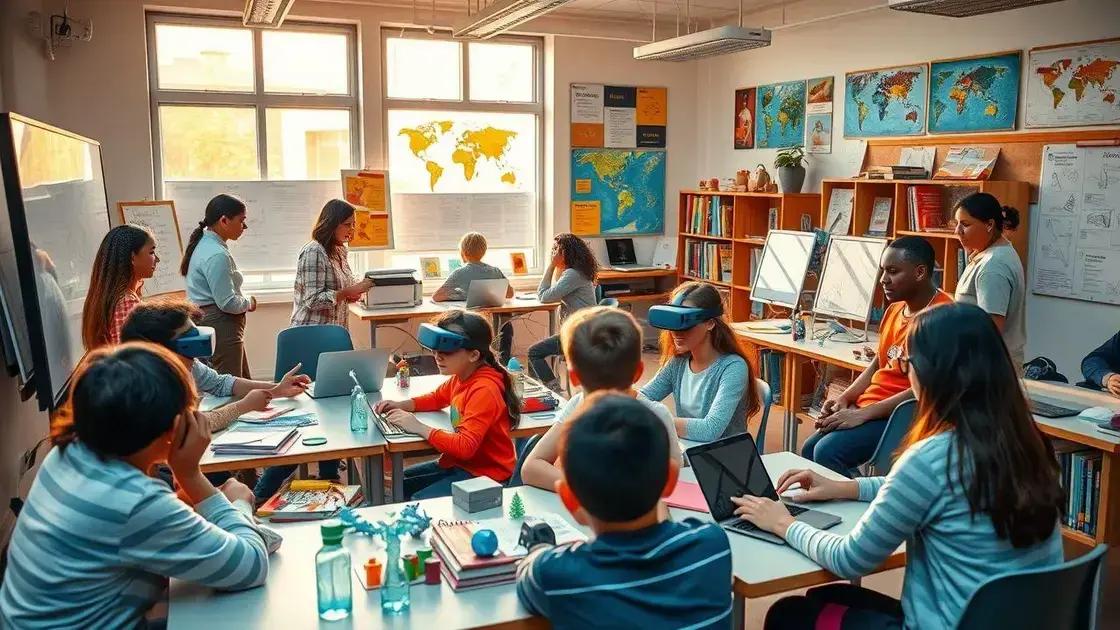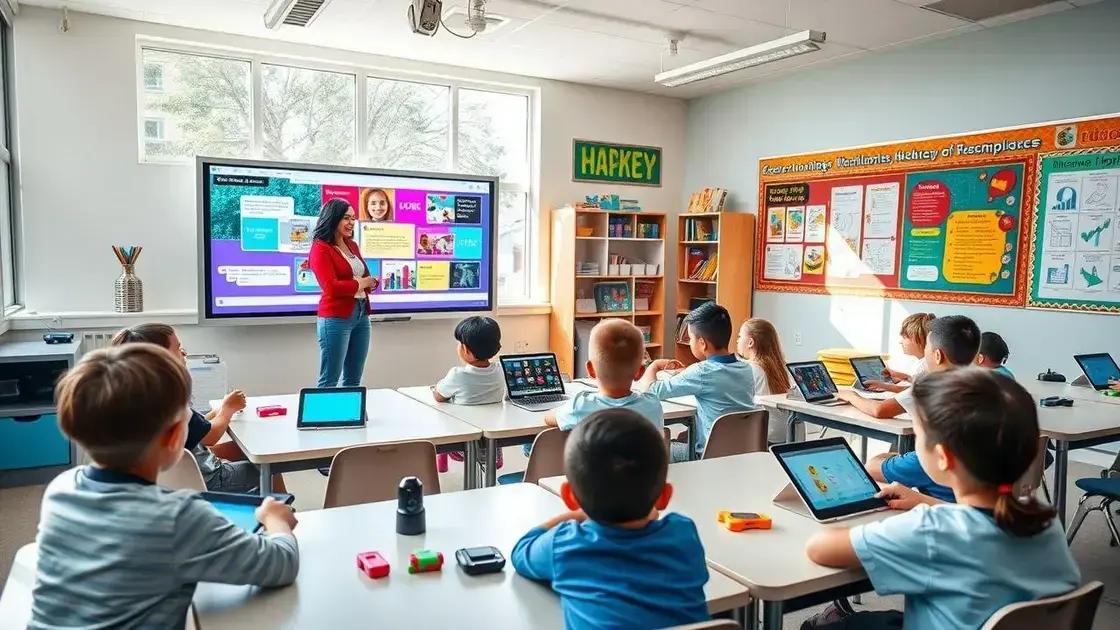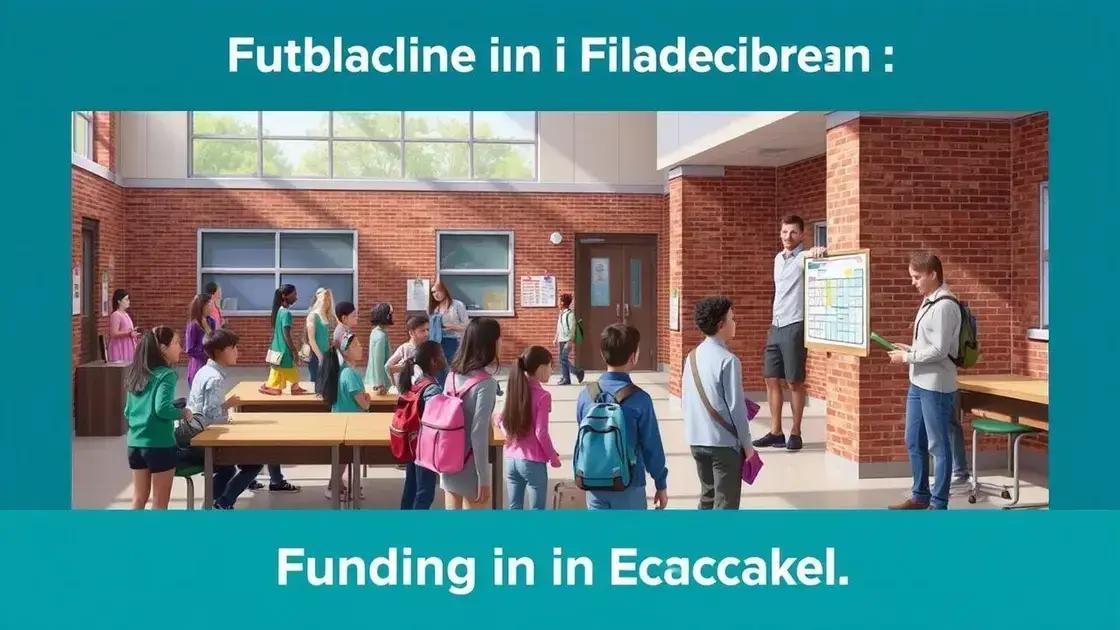Teacher workforce challenges in the wake of tariff exemptions

Attracting and retaining educators requires competitive salaries, supportive work environments, professional development, and engaging teachers in decision-making to enhance job satisfaction and educational outcomes.
Teacher workforce challenges are increasingly relevant as recent tariff exemptions granted by Trump affect educational resources. Have you noticed how these changes could reshape our schools? Let’s delve into the impact.
Impact of tariff exemptions on educational budgets
The impact of tariff exemptions on educational budgets is profound and multifaceted. When tariffs on imports like Chinese-made iPhones are lifted, schools can expect changes in their financial landscape. This shift could either free up resources or strain funding further.
Financial Implications
Schools rely heavily on budgets for technology and resources. Tariff exemptions might allow districts to allocate funds more freely, but there are other challenges to consider.
- Increased funding for educational tools.
- Potential cuts in other areas due to budget reallocations.
- New technology purchases balanced against existing financial commitments.
As schools navigate these adjustments, it’s crucial to understand how policy changes influence classroom environments. Tariff exemptions can create opportunities for improving technology integration in lessons while potentially causing budget strains elsewhere.
Long-Term Outcomes
The long-term outcomes of these financial shifts can affect education quality significantly. How funding is reallocated can determine whether schools offer essential resources or face shortages. For example, technology integration is vital for modern teaching practices. Nevertheless, if budgets are redirected without careful planning, student resources may suffer.
Furthermore, schools must prepare for unforeseen circumstances brought on by these changes. Increases in demand for specific technologies can lead to supply shortages, which might delay implementation in classrooms. Predicting these trends and adapting swiftly is vital for educators and administrators alike.
Shortage of qualified teachers and its implications
The shortage of qualified teachers is a pressing issue in many education systems today. This gap in skilled educators can lead to severe implications for students and schools alike.
Understanding the Teacher Shortage
Several factors contribute to the lack of qualified teachers. While many teachers retire or leave the profession, fewer candidates are entering the field. This decline affects classrooms across the country.
- Low salaries compared to other professions.
- High levels of stress and burnout.
- Inadequate support and resources for teachers.
As a result of this trend, schools may face larger class sizes and overworked staff. Those remaining in the classroom often feel overwhelmed, which impacts the quality of education students receive.
Implications for Students
The implications of a teacher shortage are far-reaching. When classrooms lack fully qualified educators, students may miss out on crucial learning experiences. For instance, subjects like math and science may be particularly hard hit.
Students taught by underqualified teachers can struggle to grasp essential concepts. Research shows that these challenges can lead to lower test scores and reduced overall achievement.
Moreover, the absence of experienced teachers can hinder the development of social and emotional skills in students. A supportive teacher can foster a positive classroom environment, which is difficult to achieve with insufficient staffing.
How technology influences teacher effectiveness

Technology plays a key role in how teachers can be effective in their classrooms. With the rise of digital tools, educators have new opportunities to enhance learning experiences and engage students.
Enhancing Learning Through Technology
By integrating technology, teachers can tailor their approaches to meet diverse learning styles. Digital resources allow for personalized instruction, making lessons more relevant and interesting.
- Interactive software helps students stay engaged.
- Online assessments provide immediate feedback.
- Digital collaboration tools promote teamwork and communication.
Moreover, technology can save time and increase productivity for teachers. With tools for grading and lesson planning, educators can focus more on teaching and less on administrative tasks. This balance is crucial for maintaining a high quality of education.
Challenges of Technology in Education
While there are many benefits, challenges still exist. Not all schools have equal access to technological resources, which can widen the gap in educational quality. Schools in low-income areas may struggle to provide devices and internet access for their students.
Additionally, teachers need proper training to utilize technology effectively. Without this support, even the best tools may not lead to improved student outcomes. It is essential for school districts to invest in both technology and teacher training to maximize the benefits.
As technology continues to evolve, so does its impact on teaching practices. Embracing these advancements can help educators better connect with their students and prepare them for a rapidly changing world.
The role of policy changes in workforce dynamics
Policy changes significantly influence the dynamics of the teacher workforce. As regulations shift, they can affect hiring practices, teacher retention, and overall job satisfaction.
Impact on Hiring Practices
New policies can either streamline or complicate the hiring process for schools. For instance, initiatives aimed at increasing teacher diversity often introduce new recruitment strategies. These strategies can help attract more qualified candidates, leading to a stronger workforce.
- Incentives for teachers working in underserved areas.
- Streamlined certification processes for new educators.
- Programs tailored to support bilingual and diverse teachers.
Such efforts can help ensure that schools are staffed with educators who reflect the demographics of their student bodies. This alignment is crucial for fostering an inclusive educational environment.
Retention and Job Satisfaction
Policy changes also affect teacher retention rates. Improved benefits, professional development opportunities, and supportive work environments can increase teacher morale. When teachers feel valued, they are more likely to remain in their positions for longer periods.
Furthermore, policies that address classroom conditions and workload significantly impact job satisfaction. When teachers have manageable class sizes and adequate resources, they can focus more on teaching and less on stressors.
Additionally, support networks and mentor programs can play a vital role in helping new teachers adjust to their roles. By fostering a strong community within schools, policies can enhance the overall experience for educators.
Strategies for attracting and retaining educators
Attracting and retaining educators is vital for maintaining a stable and effective school environment. With various challenges facing the teaching profession, effective strategies are necessary.
Creating Positive Work Environments
A supportive atmosphere is crucial for teachers. When schools prioritize mental health and work-life balance, educators are more likely to feel valued. Implementing policies that promote self-care and stress management can significantly improve job satisfaction.
- Encouraging regular feedback among staff.
- Establishing mentorship programs for new teachers.
- Offering professional development opportunities.
Furthermore, involving educators in decision-making processes fosters a sense of ownership and empowerment. When teachers have a voice, they are more committed to their schools.
Competitive Compensation and Benefits
Another critical strategy is offering competitive salaries and benefits. Schools can attract qualified candidates by ensuring their pay aligns with or exceeds local standards.
Additionally, benefits such as health insurance, retirement plans, and paid leave can enhance job attractiveness. Educators are more inclined to stay in a district that offers comprehensive benefits packages.
Investing in employee benefits is also a way to demonstrate that schools truly value their teachers. This practice can lead to increased retention rates and a more dedicated workforce.
FAQ – Frequently Asked Questions about Attracting and Retaining Educators
What strategies are effective for attracting teachers?
Effective strategies include offering competitive salaries, creating supportive environments, and providing professional growth opportunities.
How can teacher retention be improved?
Improving teacher retention can be achieved by fostering a positive work culture, engaging educators in decision-making, and offering mentorship programs.
Why is it important to support new teachers?
Supporting new teachers helps them adjust and grow in their roles, leading to job satisfaction and better educational outcomes for students.
What role does compensation play in teacher satisfaction?
Competitive compensation is crucial for attracting quality educators and ensuring their long-term commitment to the school.






